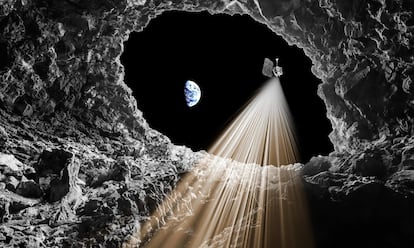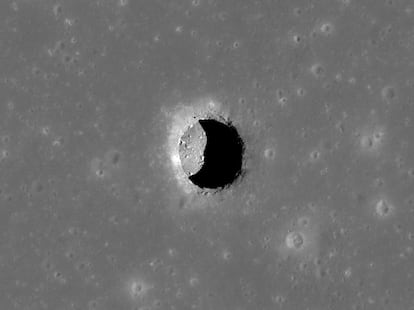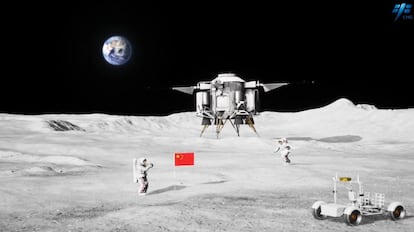Will NASA astronauts or Chinese taikonauts live in lunar caves?
The discovery of a gigantic lava tube about 250 miles from where ‘Apollo 11′ landed opens the possibility of taking advantage of these features to construct bases in the near future

A team of Italian astronomers from the University of Trento has just published a detailed analysis of a lunar cave. Specifically, a radar study of the entrance and first sections of a gallery that may extend 100 meters below the surface. Strictly speaking, lunar caves are not a new discovery. Half a century ago, Verne Oberbeck, a planetary scientist hired by NASA, theorized about their existence. The first was located in 2009, thanks to images sent by the Japanese probe Kaguya. Later, other satellites, especially the Lunar Reconnaissance Orbiter (LRO) have been adding more to the catalog. Today, more than 200 are known.
The cave now being studied is a hole 45 meters in diameter and up to 80 meters long. When the sun falls vertically over it, you can see the bottom, 150 meters below, carpeted with rocks. This topographical feature is in the Mare Tranquillitatis, about 250 miles from where Apollo 11 landed. Its origin is attributed to the collapse of a lava tube, the remaining structure of a molten material flow that occurred in very remote times, when the great lunar plains were still young. Such formations are also found in volcanic areas of our planet.

The walls of the Tranquillitatis cave seem to have been cut with a pickaxe. Depositing a vehicle at the bottom would require lowering it with something like a crane. Others, on the other hand, have slopes with ramps of about 45º, too steep for a wheeled vehicle to negotiate, but there are alternatives: a leaping robot with legs that could be quite at home exploring these chasms is being studied.
The Italian astronomers’ work was based on radar data obtained by the LRO more than five years ago. It happens: the reels of magnetic tape on which the data are collected can spend ages in storage until someone needs them for a particular study.
This was the case with hundreds of images transmitted by the Lunar Orbiters in the 1960s in preparation for the landing of the first astronauts. Once they were used to select the safest landing sites, they lay forgotten in a warehouse until an analyst discovered them. Not only the reels, but also an obsolete copy of the machine that would allow them to be read. When the photos were passed through a modern image processing system, their quality astonished the technicians. It had never been possible to achieve such clarity with the old analog equipment.
This time, the key was a slight excess of brightness in the radar echoes observed in the vicinity of the cave entrance at Tranquillitatis. By running different simulations, the researchers concluded that the cave extended beyond it, perhaps as far as 50 to 80 meters. That is a cavern the size of an Olympic swimming pool. If that was the case, it would be a good structure in which to establish a shelter for future astronauts. At that depth, they would be safe from meteorite impacts and the bombardment of cosmic rays would be greatly muffled. In addition, as occurs in terrestrial caves, the minerals would help to moderate the temperature differences between day and night.

The authors of the cave study note that its accessibility and the slope of the conduit are promising for establishing a lunar base, and that such caves could be common beneath the lunar plains. They also noted that it could be crucial for lunar missions, as the Moon’s surface is extremely hostile, with temperatures of between 127ºC and -173ºC and high cosmic and solar radiation. Therefore, finding safe sites for infrastructure, such as these caves, is essential for sustained exploration. NASA had already considered the possibility of establishing a future base by covering its walls with a thick layer of lunar regolith. Initially, China had also hinted at that option, but so far no concrete plans have been announced.
About six months ago, a video was leaked from the China National Space Administration — probably intended for internal consumption — revealing details of its plan to colonize the Moon. It mentioned the use of magma tubes to build subterranean habitable modules, inflatable structures that would be lined with insulating material by robots, and the construction of an orbital station around the Moon from which to control robotic exploration and resource-seeking missions.
The video also raised the possibility of drilling tunnels in the surface by launching a missile from lunar orbit. This hypothesis sounds more like science fiction than reality, but we are talking about a long-term plan, in which China would probably collaborate with Russia in the launches and construction of the future International Lunar Research Station.
Sign up for our weekly newsletter to get more English-language news coverage from EL PAÍS USA Edition
Tu suscripción se está usando en otro dispositivo
¿Quieres añadir otro usuario a tu suscripción?
Si continúas leyendo en este dispositivo, no se podrá leer en el otro.
FlechaTu suscripción se está usando en otro dispositivo y solo puedes acceder a EL PAÍS desde un dispositivo a la vez.
Si quieres compartir tu cuenta, cambia tu suscripción a la modalidad Premium, así podrás añadir otro usuario. Cada uno accederá con su propia cuenta de email, lo que os permitirá personalizar vuestra experiencia en EL PAÍS.
¿Tienes una suscripción de empresa? Accede aquí para contratar más cuentas.
En el caso de no saber quién está usando tu cuenta, te recomendamos cambiar tu contraseña aquí.
Si decides continuar compartiendo tu cuenta, este mensaje se mostrará en tu dispositivo y en el de la otra persona que está usando tu cuenta de forma indefinida, afectando a tu experiencia de lectura. Puedes consultar aquí los términos y condiciones de la suscripción digital.
More information
Archived In
Últimas noticias
Most viewed
- Pablo Escobar’s hippos: A serious environmental problem, 40 years on
- Why we lost the habit of sleeping in two segments and how that changed our sense of time
- Charles Dubouloz, mountaineering star, retires at 36 with a farewell tour inspired by Walter Bonatti
- Reinhard Genzel, Nobel laureate in physics: ‘One-minute videos will never give you the truth’
- The Florida Keys tourist paradise is besieged by immigration agents: ‘We’ve never seen anything like this’











































